
Richards Grassfed
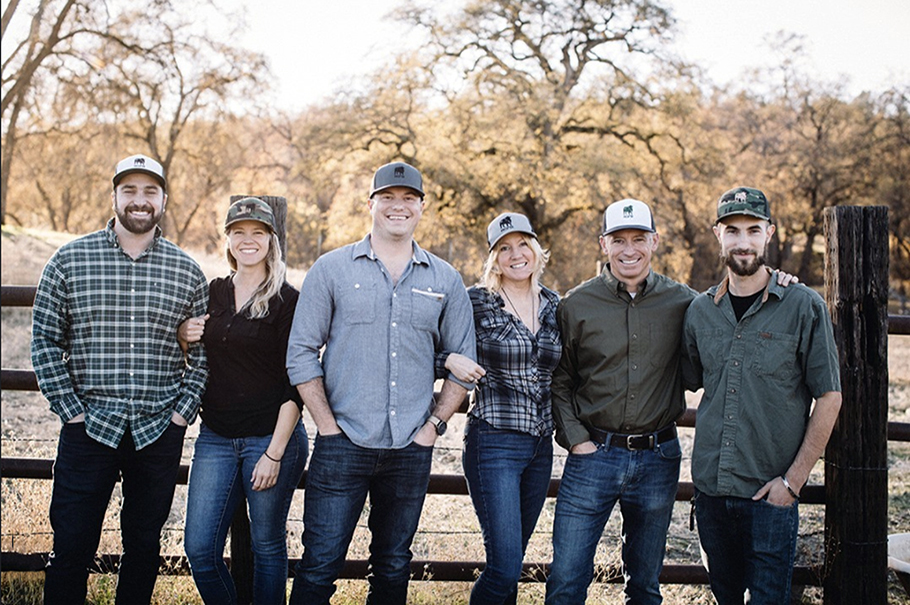
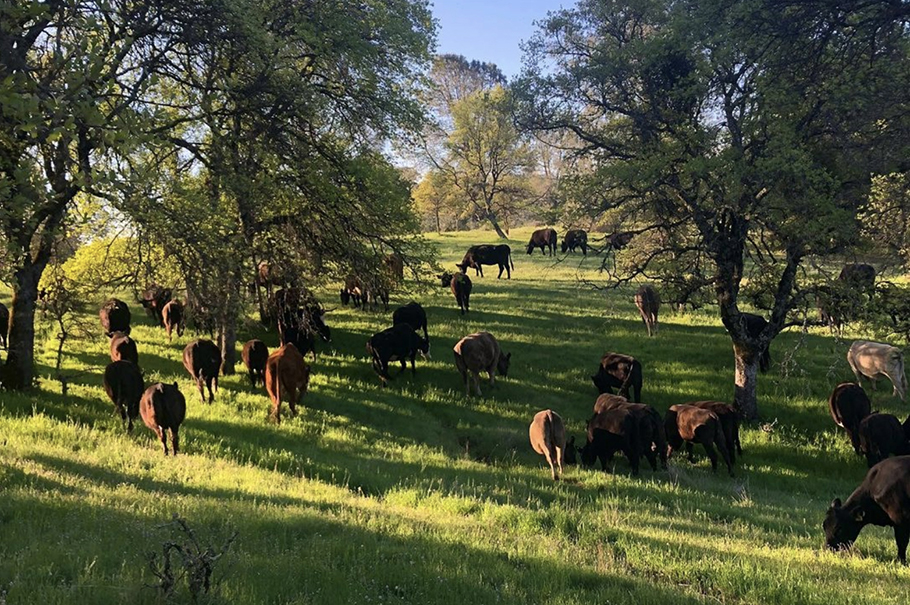
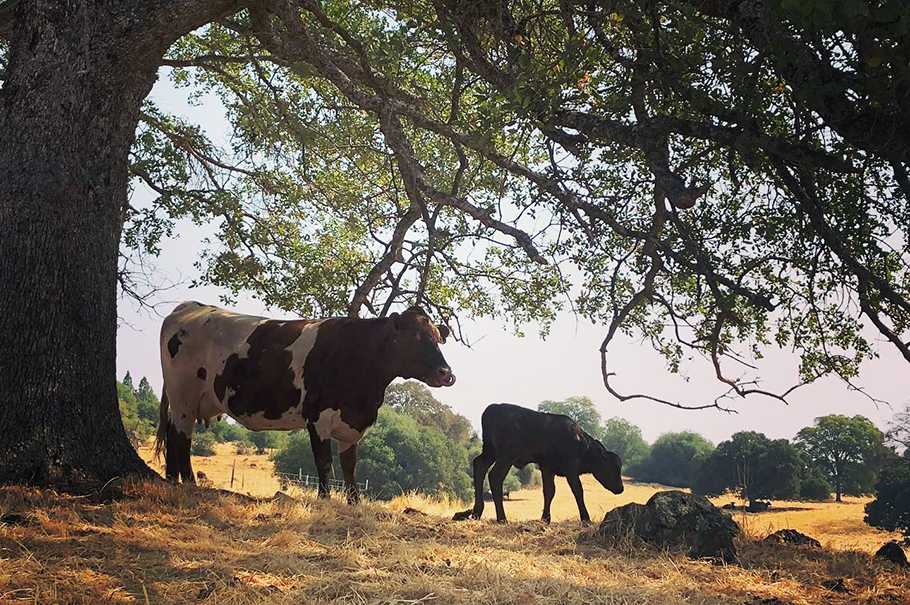
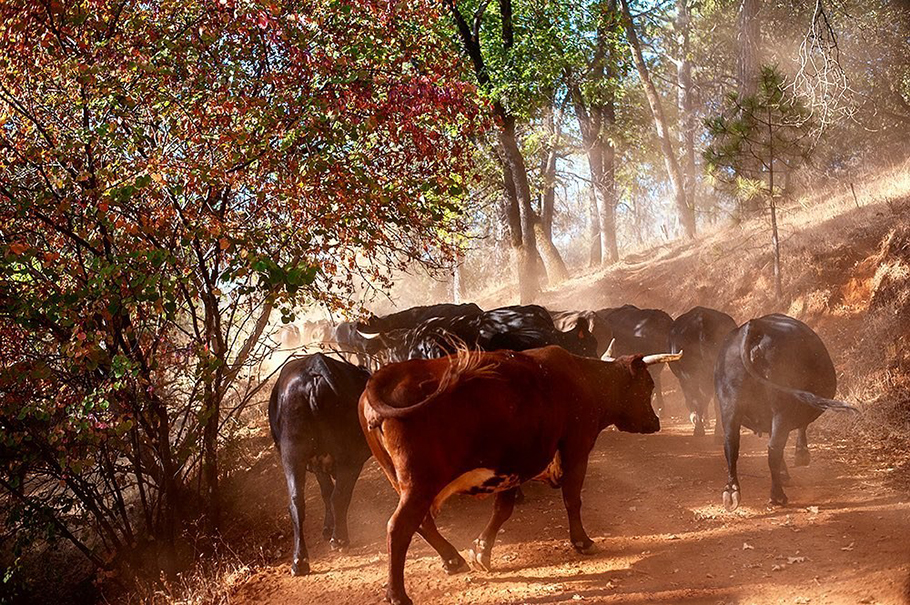

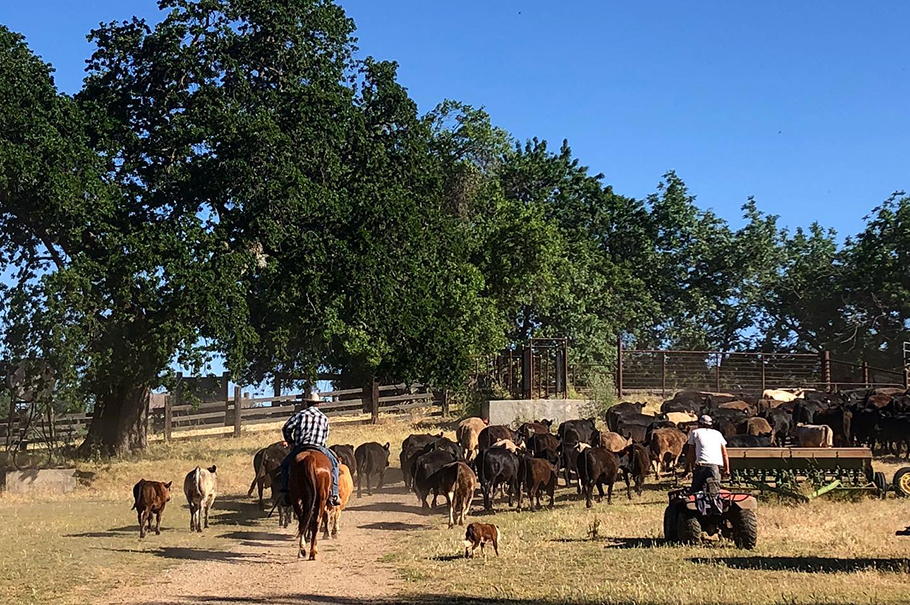
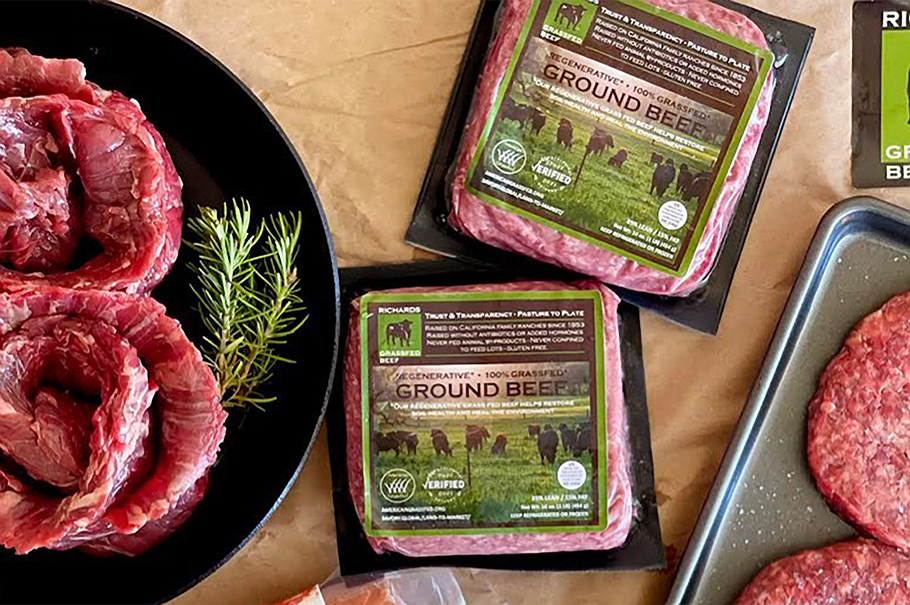
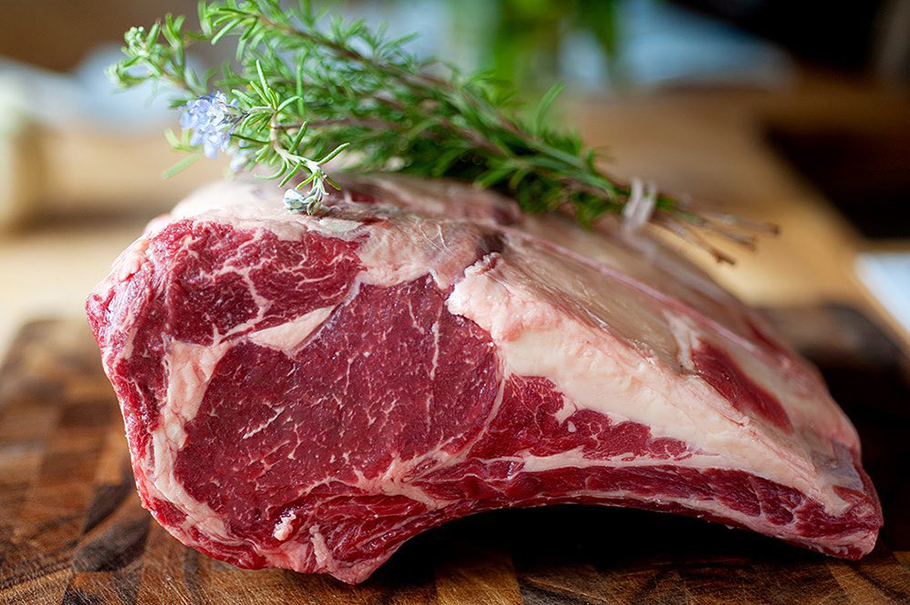
The Richards family has been involved in agriculture since 1941 when Thomas H. Richards Sr. purchased a 680 acre parcel in Yuba County, CA. Today the Richards Ranch is comprised of 6600 acres. They ranch all of it except for 700-1000 acres of steep slopes that go down to the Yuba River. Carrie Richards took on the project of operating the ranch in 2016 and about a year started the process of converting to regenerative practices. Currently half their operation (about 2800-2900 acres) is devoted to regenerative grazing.
“The reason why," Carrie explains, "is that the ranch is set up with lots of fencing in the area that we are managing pretty close. But there’s lots of areas with no fencing, and some of the property is steep without a lot of water sources. So I’m working with NRCS to develop those water sources in the back country so we can manage those areas better in the future.”
That gives them plenty of opportunity to compare and contrast techniques, something that suits Carrie extremely well. Before getting into Holistic Management she spent a lot of time online researching ways to work with her animals either through “densing them up” or rotational grazing. But she believed she needed more of a roadmap and, serendipitously, American Grassfed referred her to the Savory Institute.
“I took all the courses. And when I realized that you could ranch a different way it was really exciting. But it was also VERY overwhelming. Because with the old way that we were running things, although it wasn’t terrible I could see that things were not looking so hot certain times of the year. And when it came to keeping the herd together, we were not doing that. We had all these different herds. It was a little bit more complicated than it needed to be in an already complicated business. So I slowly moved towards that regenerative model.”
Richards Grassfed Beef is now certified by the American Grassfed Association and is the first beef company on the west coast to receive the Savory Institute's Ecological Outcome Verified certificate.
Carrie is currently participating in a study with CRARS on cover cropping, no-till techniques, and compost. She also hosts NRCS projects on her property to assess grazing practices on grass growth.
Transitioning from Conventional Ranching to Regenerative
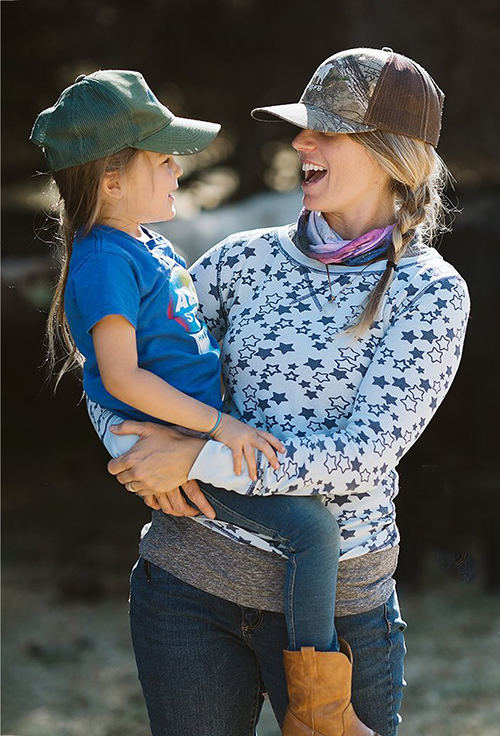
Richards says that the reason for this transition was “we weren’t profitable. That is the number one very blunt reason. We were buying a lot of hay. And I thought that if maybe we could do this differently we could grow more grass and buy less hay. That first year we cut the hay bill by two thirds and it was really scary. But we just improvised and wound up using some of our outskirt rangeland because it was a good water year that year. I was able to push the animals into areas where we don’t have fencing and electric fence them in. We just got through it that first year! We bought so much electric fence and overbuilt pastures, and the cows would blow through them because they were not used to it. It was comical at times.” But then came the day when they realized, “Oh! This is possible. Everybody’s okay!”
So they kept trying things out and kept going. And things got better.
“We’ve gotten a lot better! And something that I’ve gotten better about is that I’ve relaxed a little bit. I was very obsessed with having to move the cows every day and that they had to eat everything evenly. Like, ‘everyone has to eat their vegetables!’ Because you read these books and certain people say to move them four times a day. Four times a day! How do you do that with two people? There’s two or three of us at the most. So I’ve relaxed a little bit about things like that which has been helpful and it takes the pressure off.”
Part of Holistic Management is that the rancher is part of the holistic system. The choices have to work for the people involved.
“I have two little kids so to put pressure on myself to be the perfect regenerative farmer is just insanity. In the last two years, I’ve been saying, ‘okay, we’re just going to do the best we can, especially in the growing season.’ A lot of life on the ranch is happening at that time and if we can pay attention and do a really good job then, it really sets us up for the later season as well.”
“It’s important because when you’re young and excited about this and you don’t have kids yet, you can do all these things. But when your life adjusts then you have to adjust with it. Keeping your land healthy shouldn’t come at the sacrifice of keeping yourself healthy.”
One of the adjustments they made was to ship the cattle away in the summer.
“What regenerative means to me is giving your land the opportunity to thrive, whatever that means! In my place we are dry as a bone in the summer. And we don’t have irrigation—just a very small amount—so the best thing I can do for that soil is keep it covered when it’s hot. Something we’ve done for the last year and a half is send our animals up north in the summer to Modoc County. Our cousin is up there and we have some connections to a sub-irrigated property where the weather is cooler, and the mamas come back very happy and fat. So our cows are not here and they’re not drinking out of the ponds which is nice so we can keep those water sources as full as possible. And we’re not grazing those lands down to the dirt and letting the sun nail it for three and half months. So that’s been one big adjustment that we’ve made.”
Carrie is also very excited about the cover crop and no-till project she is doing with CRARS. “We’re on the third year of it. The first year we didn’t see a lot of growth, and last year we didn’t see a lot of growth until it came late! It came AFTER Cindy Daley came and measured. Everything was really off last year, as we know. But when it came, it exploded! The forage in the field in the areas that had the inoculated seed really exploded. So I’m really excited to see what happens this year to see if it changes even more.”
The NRCS projects have also informed some changes. “They do clippings of our rangeland at certain times of year, like during fast growth and during times of slow growth. The information that we got out of that so far is that if we graze it early in the growing season and then come back later and graze it again we get a lot more growth than if we were only to graze it one time! So that’s been really interesting.”
Richards is also experimenting with multiple animal integration.
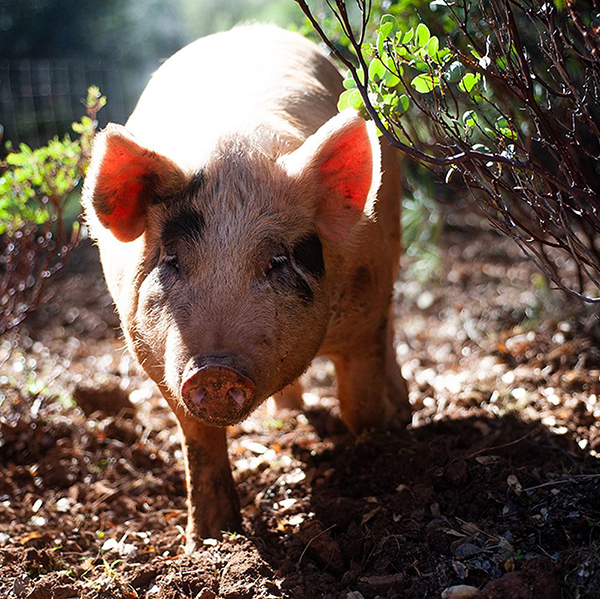
“Something that’s new in the last year and a half is that we’re finishing pigs on pasture. We are bringing in weened pigs and running electric fences in the trees. And we’re using them as a clearing tool because there is a large area of our ranch that is covered in brush and trees and can’t be grazed with cattle because there’s not a lot grass. So the pigs have been really great about disturbing that land. They take care of some of that understory and ladder fuels so you can get into those areas. And then we come back a year later and graze it with the cows. This is the second year that we’re doing that, and in all the areas where the pigs have been we have lots of nice new grasses coming up.”
“It’s been really cool. And it’s been challenging because they’re a different animal. Once they get out they’re not very good at being herded back in. They just bolt on you! So that’s been a challenge but it’s been a really easy product to market because we’re not confining them. They’re not in any sort of scary barn situation. They’re out, they’re rooting. We don’t ring them so they’re rooting and eating grubs, and we’re supplementing with the healthiest stuff we can find. Farmers give us their excess fruit and it’s been a really cool system.”
“We also have sheep. We sell them whole to neighbors and friends. We have them because my dad liked them, and then it blew up into this herd of 300 and we didn’t know what to do with them! So we started bringing the sheep in behind the cows [as shown in the video lower on the page], but it was a lot of labor because the sheep are so much smaller than the cow herd. And last year when it got really dry we had to sell most of the sheep because we couldn’t afford to feed them. But we still have a very small herd and I may buy more sheep for a limited period of time to do some targeted grazing for us for fire prevention. I think what I’m going to do is just bring them in at certain times of year. Managing pigs, cows, and sheep year round for us—getting back to the holistic concept—is just not feasible. But I want the impact that they have and I want to make sure we keep our ladder fuels down for the neighbors. I do think they are an amazing tool, especially here in California. I just think that for us seasonally is the best bet for that.”
Part of Carrie’s thinking is that summers keep her very busy with her kids. “How do we get all this awesome animal impact but don’t have a labor cost that’s super high, work ourselves to death, and have our kids standing around always saying ‘are you done moving the sheep?’ So I’m trying to figure out how to get all this cool animal impact and not completely wear ourselves out. Obviously, this is a challenge that everybody has. But I’ve kind of figured out that seasonal animals are the way for us. When the cows are gone, the sheep are here. When the sheep are gone, the cows are here. By rotating things around so it’s not so overwhelming.”
Special Equipment or Tools Needed For Regenerative Ranching
“We didn’t get a no-till seeder or anything like that because we wanted to see how this was going to work. Our biggest investment was about $12,000 in electric fencing. We have a lot of hard fencing but our pastures are 200 acres and 100 acres and 40 acres and two acres! They’re kind of all over. And since we didn’t know how this was all going to work, we just used electric fence to divide the bigger ones up. It’s been really great because we can calculate: okay, we have 200 acres, we’re going to move 400 animals into here, we’re going to move them every two days. . .”
“As far as other tools, I actually sold a lot because you don’t really need a lot of things when it comes to this. Our biggest tool is rest. When we gave those pastures rest that had not had rest in a decade, they exploded! They had years and years of dung and urine on them and all that life ready to explode. So the tool of rest was a big one for us. And it still is.”
“Now we’re working with Cindy to do cover crop trials in the pastures near the house to see what works. One of them seems to be really working—inoculated seed seems to be a really great tool. I’m excited to see what it does the year after she doesn’t seed. What does that look like and how long does it last? Because it’s a really cool tool to maybe boost areas that are hard to get to or are suffering and need a revival. That’s why I work with people like Cindy and the NRCS to do a lot of these little experiments. I want to know what works on our land. And to pay for all of these out of our own pocket would be expensive. Working with other people is exciting. I’m probably going to go for a Healthy Soils grant. I want to try some compost application and some mulching, and I want to try them side by side. I don’t know if that’s possible with these grants, but I want to see which one has the better result. I’m excited that the Healthy Soils grants(opens in new window) are still being funded.”
“Something that is cool about these practices is to measure what the effects are because eventually as farmers and ranchers we can put the practices into our budgets. If I know that I spent $12 grand on compost—which is a scary number—but it gave me $100,000 in production, well that’s something. As the measurements get more and more precise, that’s going to be such incentive for people to do this stuff. That’s why it’s so nice to have these grants so you can try things.”
Richards Grassfed Beef: What is Regenerative Agriculture?
Results to Share
Speaking of measurements, Carrie says that a willingness to test her soil from the start has made a big difference.
“I am so lucky I had an amazing Point Blue woman that I was working with right when I got here at the ranch and she got me to baseline my ranch. I don’t know why the stars aligned and I said ‘sure, let’s do it!’ But in the three years between remeasuring we increased our overall carbon in our soil from .4 tons to 1.3 per hectare. That’s apparently more than the overall Sacramento Valley area—we’re trending above the average. So that’s super exciting!
“We measured five pastures. One of our pastures is doing terrible. So what’s happening there? Well, the trend we saw there is that there is an invasive species present that is not as present in the other pastures. And the carbon sequestration is much lower there. So is that the connection? It’s interesting to have these measurements because then you have the tools to know how to fix your issues. Like knowing what time of year to overgraze our Medusahead to make sure it doesn't come back. Maybe I was grazing it too early and it was regrowing and thriving. Maybe I have to address it later in the year so I can stomp it out. Things like that are really helpful to learn.”
Similarly, she says, “We recently had a biologist out who measured our vegetation and soil by comparing the same soil profile and slope on a piece of property that is managed ‘set it and forget it’ style and then one that is managed more holistically. The species richness of plants was 10 fold on the spot managed holistically versus the other rangeland.” They don’t have the soil lab results for other factors yet and look forward to finding out those results.
Richards has also noticed a few things through her own lived experience.
“There are two very apparent things that I’ve noticed. 1) Our riparian areas are getting wider and staying green longer. And 2) this year we have had more deer than we’ve had since I moved here. The year I moved here, the hunters told me they only took one deer off of 6500 acres—there was nothing here—and that was concerning me because everybody’s connected to the next level of predator and prey. I’m doing a better job of leaving the grasslands later in the season or not grazing them when the deer come in the Fall and have their fawns. I don’t know if it’s directly connected but it seems like the quail and dove populations are increasing. I’m trying to work not only with the soil but with the wildlife—improving the whole system. I can’t say that my practices have turned out more deer and quail and dove, but that is something I’ve noticed. And the hunters who are out in every corner of the property have definitely noticed.”
Profitability Is Coming Along Nicely
Carrie Richards is very enthusiastic about the ranch moving into profitability even though that goal is still in progress.
“We’re SO close! California is expensive, and it is expensive to raise a cow from birth to slaughter weight. I’ve changed our calving season and with sending the cows away in the summer, the cattle are finishing a little quicker. Bringing in other species for short amounts of time has also been very profitable. The pigs have been profitable because they are coming in and doing a job for us. That way we don’t have to use diesel, and then we’re selling them for meat. The combination of tightening expenses and trying new things have helped me move towards profitability. I’ve also been able to take in pasture cattle in the winter because with our grazing plan we have more feed to eat. So this year we’ll make some income on that as well. Things are slowly moving in the right direction. This year, by the skin of our teeth, we are going to break even, which we haven’t done in a really long time.”
“People are starting to understand what regenerative means now which they didn’t before. Two years ago when we did the EOV Land to Market program with Savory I felt like we were the first people at the party. People liked what it meant but they didn’t get it. It is hard for people to understand that animals could actually help an environment versus degrading it. So now that there’s a lot more education out there and people have seen movies and videos about regenerative agriculture, and there’s all this excitement around it, it makes it a lot easier to market.”
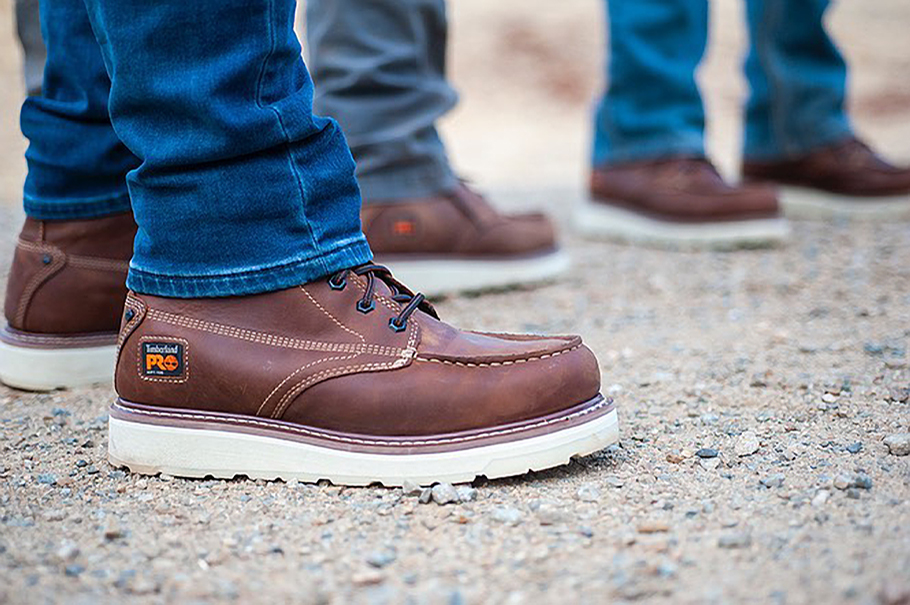
An example of that is selling their hides to Timberland for their line of regenerative boots(opens in new window).
“It took two years to get our leather into a regenerative system. We sell into the Timberland boot program along with three other larger farms that are all part of the Savory network. We sell them to a third party who then sells it to Timberland. But it took almost two years to get it to happen because the commercial cattle avenues of where products are sold are hard to disrupt. To break away from that, either it gets really expensive so people don’t do it or it gets too complicated. We have a nice partner that we’re working with. They’re managing our hides and when we say, ‘hey, we want to sell them to these people,’ they say, ‘okay,’. This way we know our hides are going to people who are looking for them. All these little things are building . . . it’s all coming together. It’s really exciting.”
One of their planned marketing efforts is to do farm tours, and in particular she wants to educate on how Holistic Management can look different in different regional conditions.
“We were going to open up a half dozen farm tours and dinners last year which would have helped the bottom line a lot but that didn’t happen [because of COVID]. And this year it wasn’t quite back yet so next year we’re going to try again. What creates excitement is when you bring people out and you show them physically what you’re doing and explain, ‘Yes! Joel Salatin does that in his environment. But here in California this is what we’re doing and how we’re doing it and these are the results we’re getting.’ Sometimes people get stuck when they hear about regenerative or rotational grazing or AMP or whatever you want to call it, that you have to move the cows every day and then you have to move the sheep behind them, and then you have to bring in the chickens. That’s what you have to do! (laughing) But you don’t have to do it that way! It’s great when you can bring people out and you show them what you are doing—how different is fine and this is how you can do things in California. Bringing people out is one of my favorite things so I’m hoping we can get that going again.”
Next Steps for Richards Grassfed
Carrie Richards shared her thoughts in this way:
“My priorities of having the most successful meat company have really shifted to: How do I keep this property thriving? How do I keep it in the family? How do I keep the family interested in this lifestyle? And if they’re not interested in this lifestyle, that’s fine. And if it isn’t us who owns it, who is going to own it, how are they going to run it? Keeping these large swaths of land together in California, I think is really important for wildlife and it’s important for agriculture. It’s become more of a priority to me than whether we keep the land, whether we ranch it, whether our kids ranch it. I want to keep it for the family, I want to keep it for the next generation, I want to keep it whole for the wildlife, and I want to keep the watershed healthy. So how do we do that? That’s been a shift in my priority as far as our land goes.”
“As far as the beef company goes, we’re starting to sell into the school system which is really exciting to me, having school age kids myself. We’re in different school districts all around California and that’s growing. It’s us and a couple other ranchers because, obviously, we can’t supply all that meat by ourselves. It’s through CAFF [Community Alliance with Family Farmers] and Healthcare Without Harm (PDF) (PDF) (PDF). We’re trying to build a system that works and is inexpensive enough that the school districts can use it but also not pulling more from the farmers and ranchers. That’s been a really exciting avenue that we’re going down and something I am focused on growing.”
“The great thing is that I can finally have priorities now that the ranch is a little bit more stable. Before it was: ‘Make ranch stable!” Number One priority!’ Now I can see the horizon and I can focus on these projects that are bigger than me.”
“There are long, medium and short-range plans. The long-range plan is keep the ranch in the family, grow the beef business and grow our ranching producer network to keep the business evolving. For our meat company we also buy from other Savory-accredited ranchers—some are our family and some are outside our family. The bigger that Savory group grows, the bigger our rancher-producer group can grow. The more we grow the industry of regenerative as a whole, the better for all those land bases and once people will see a benefit in ranching this way they will want to join us!”
“Also, with expansion comes price cuts. We’re harvesting more animals so we’re get better pricing, and then the customer is getting a better deal. We would like to stay regional. But what does that look like? How do we create these regional systems so that we don’t have the issues that we’ve had in the last couple of years? On the long-term side, how do we get these regional systems together and how do we keep them healthy so that when there’s . . . you know, when the world shuts down . . . we can pivot quickly, locally, to keep everything running?”
Advice to Others
“I remember being really excited about learning what regenerative was and how plants grow and how to use the animals to increase soil health. But I also remember coming home from those classes and thinking ‘omigod, where do I even start?’ I remember that feeling and—I don’t know who said it—but the advice was ‘just start. Just start something.’ That first year, we took a small herd of just 40 head and we built these tiny little pastures with electric fence. The first time we did it, it was horrible. They blew out the fence and we had to rebuild everything. But we tried it and it seemed to work a little bit. And so the next year we did more, and the next year we did more. It was just plan, monitor, replan, which is a Savory thing
You have to pay attention to what you’re doing, you have to write it down and take pictures. That sounds overwhelming as well but, in the end, things have really gone in a cool direction. We’ve learned so much! Our animals are healthier, our calves are healthier, and overall I really think that this is a very, very, very exciting way of ranching and farming. That is not new! It’s very old. But going back to this way, if we can become more and more efficient at it, I think it’s a wonderful answer to the question that everybody’s asking: ‘how do we grow the food system and how do we take care of the planet?’ I think that it’s an overwhelming thing to tackle but if you just tackle one little piece at a time, then it becomes way less overwhelming.”
One step at a time—sounds like good advice for life!
